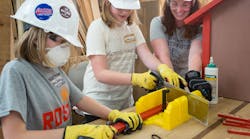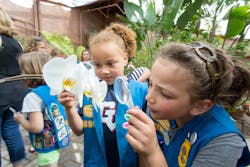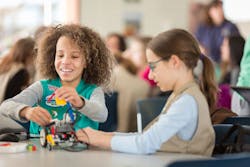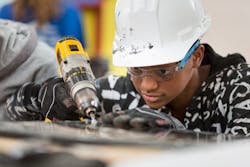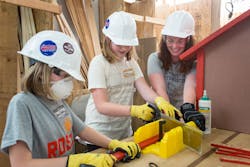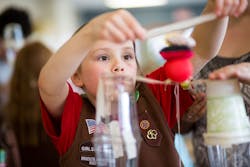This summer, I had the privilege of witnessing 45 middle school-aged girls from the Girl Scouts of Minnesota and Wisconsin River Valleys come together at Dunwoody College of Technology for a day of construction engineering. Led by women in the field, the girls strapped on helmets and protective gloves and got to work, learning such skills as welding, plasma-cutting, and wood-working. As always, we concluded the program by soliciting feedback:
What was your favorite part?
What would you like to see more of?
Their enthusiasm was overwhelming. The girls loved the activities, and what constructive criticism they had to offer was unified by a single clear thread: we want more challenges. My personal favorite response came from a girl who wanted, and I quote, “more dangerous things.” As if blowtorches and buzz saws weren’t dangerous enough already!
In 2012, the Girl Scout Research Institute (GSRI) collaborated with Lockheed Martin to learn more about girl interest in STEM. What they found confirms what many of us at Girl Scouts River Valleys have observed anecdotally—that the overwhelming majority of teenage girls (74%) are already interested in STEM. So why do women hold only 25% of STEM career positions? What happens in between? Why isn’t interest translating into action?
One might attribute these outcomes to girls feeling discouraged by the difficulties associated with pursuing careers in male-dominated fields. According to the same study, nearly half (47%) of all girls say they would feel uncomfortable being the only girl in a group or class. More than half (57%) of all girls say that if they went into a STEM career, they would have “to work harder than a man just to be taken seriously.” These percentages are higher for African-American and Latina girls. For example, half (50%) of African-American girls agree with the statement “Because I am female, I would NOT be treated equally by the men I studied/worked with if I pursued a career in STEM,” compared to 30% of Caucasian girls.
It is, fortunately, not so simple and far from hopeless. The same study shows that, of girls who are interested in STEM, 95% agree with the statement “If I try really hard at something, I know I will succeed.” 91% of girls interested in STEM agree that “Obstacles make me stronger.” Girls are very much aware of the challenges—and they are saying “bring it on.” So how do we provide these incredible girls with the support and opportunities to turn their casual interest into serious engagement? The Girl Scout way!
Girls Scouts has been the premier leadership organization for girls for more than 100 years, and the results are all around us. Girl Scouts make up 50% of female business leaders, 76% of female U.S. Senators, and—get this, a whopping 80% of female tech leaders. The mission of Girl Scouts is to “build girls of courage, confidence, and character who make the world a better place,” and one way we accomplish that mission is through STEM. In fact, along with Entrepreneurship, Life Skills, and Outdoor Skills, STEM is one of four major content areas identified as being the most valuable for girl leadership development.
At Girl Scouts River Valleys, our goal is to build girls’ interest, skills, and confidence in STEM. It is around those tenets—based on research and direct experiences with real girls—that we create all of our STEM programming, meetings, events, and other STEM experiences for our girls.
Is She Interested?
Research shows that girls who have an interest in STEM are more likely to try new experiences, have a positive self-image, work collaboratively, and enjoy problem solving. How, then, do we cultivate that interest? Girl Scouts River Valleys uses two main strategies. First, we engage girls with hands-on, exploratory programming. Girls want more challenges, danger, and hands-on experiences. We know already that is why so many of them come to Girl Scouts. They get enough textbook learning elsewhere.
For one event, we teach second-through-fifth grade girls about simple machines and have them build their own Rube Goldberg devices. Before the event begins, we set up three long tables full of tantalizing objects for use in their creations: string, wheels, cups, hangers, books, dominos, plates, and more. When girls first enter the room, they light up. “Do we get to use all of that?” “Is that for us to build with?” Getting to say “Yes!” is one of the best parts of my job. This kind of fun, kinesthetic engagement allows girls to experience firsthand what it’s like to be an engineer, and that firsthand experience is proven to increase their interest far more than just reading about it ever could.
For most girls, however, “fun” isn’t enough. As a colleague of mine often says, “We could take all the girls to a waterpark and they would have a great time, but they wouldn’t keep signing up for Girl Scouts year after year, because that experience is not meaningful to them.” The same GSRI study shows that girls crave meaningful experiences. They want to help others. They want to make the world a better place. In fact, 94% of girls interested in STEM agree that “helping people” is important to their career choice. Too often, adults fail to help girls understand how STEM can make a positive difference, which likely accounts for more than a few promising girls abandoning interest in STEM.
At Girl Scouts River Valleys, we aim to weave real-world problems (and solutions!) into our programming. Whether it’s learning about water conservation, creating prototype robotic assistive technology, or building a tiny home to donate to an organization that can use it—no, seriously, our girls are going to build a house at construction engineering camp this year—girls get more excited about STEM when they see its real-world applications.
Is She Learning the Right Skills?
As a middle school girl, I was obsessed with Charles Darwin—his work, biographies, sketches…anything I could get my hands on. He was not, however, a role model. He felt too mythical, too towering in his singular genius. I could not see myself in that kind of figure. It didn’t help that, like most so-called “geniuses,” he was a man.
Unfortunately, this narrative of the “singular genius” is how too many of us learn about the history of scientific progress, and promoting an unattainable, idealized image that few girls can relate to may hold girls back from pursuing STEM. Scientists, engineers, and programmers are human beings, and they had to learn, work hard, and make lots and lots of mistakes. At Girl Scouts, you don’t need to be a “genius” to be good at STEM. Instead, we focus on developing skills that real STEM professionals use every day. We teach girls process-oriented thinking and how to work collaboratively.
More than any one math formula or programming language, girls need to know how to ask questions, break problems into smaller pieces, design and build collaboratively, and strive to create solutions that benefit everyone. Instead of telling girls that the triangle is the strongest shape, we teach them to understand and apply the Engineering Design Process, and the realization that the triangle is the strongest shape emerges organically from their own problem-solving. At all our STEM events, meetings, and camps, girls work in teams to solve problems. They learn that engineering is almost always done in teams—which means you don’t need to have all the answers, but you do need to be able to listen, collaborate, and compromise.
Perhaps the most valuable skill a girl can learn through STEM is the ability to learn from failure. I think we are often scared to let our girls fail. Because we want them to feel confident and excited about STEM, it’s hard to resist helicoptering over their experience or telling them how to solve a problem. Research, and my own experience, proves that girls learn more and gain more confidence from being able to fail and try again. At the aforementioned Rube Goldberg event, one girl noted, “If something doesn’t work, make it again.” She gets it. Our STEM programming values failure—it means you tried something! It means you can learn something! It means you can do it better next time! That said, learning through failure is only possible in an environment where girls feel safe.
Does She Feel Confident?
One day in middle school science class, we were studying the planets in our solar system. Each student was huddled around their project on one of the planets, and I was very excited to be learning about outer space (always a favorite of mine). My experience kept being interrupted, though, by flying projectiles.
Several boys in my class were bullying me that year, and would constantly throw paper balls at me when the teacher was distracted. To add insult to injury, these boys carried themselves with a sense of effortless confidence in the classroom that made me second-guess my own abilities.
I felt alienated. I felt confused. I felt stupid. These emotions do not help a person to learn. In fact, research shows that—while moderate stress levels facilitate learning—once those stress levels escalate to panic, learning becomes impossible. Cut to the present day, where I mentor girls who are building catapults and even robots that launch projectiles into the air, and I can’t help but feel a little smug. Our program’s success is only possible because of the all-girl environment. Put frankly, when there are no boys to dominate the room, girls learn better. They are more likely to take risks, fail, try again, and feel comfortable doing it.
At the end of our robotics program, girls share the robots they designed and built with the rest of the group. They make posters detailing their design and do a demonstration, allowing other girls to ask questions. Last year, one girl wrote on her poster, “I must remind you, Joey 2.0 was programmed in 2-3 days, and yes, there could be a lot of tweaks, but no matter.” This, to me, encapsulated the freedom of that all-girl environment. Girls can show their works-in-progress, they can admit that things aren’t perfect—without apology!—and they aren’t worried about being judged by their peers.
In fact, I witnessed girls from different groups mentoring each other, giving advice, teaching another girl a tip or trick. This collaborative, comfortable experience is only possible when girls feel free to be girls, and research shows that the confidence developed in all-girl environments like this one, stay with them even when they move into coeducational spaces.
Taking that girl power a step further, Girl Scout programming is also largely girl-led. This means girls often plan their own experiences, make their own choices, and solve problems with their own unique perspectives. During engineering challenges, we always answer girls’ questions with more questions. A girl may ask me, “Why does my tower keep falling over?” I would respond, “Where is it falling? What could you do to help that area?” And while it is often tempting to directly intervene when we see a girl struggling with a problem we know how to solve, we never touch a girl’s project without her explicit permission. By the end of the program, girls feel like they led the experience, not the adults. They are proud of their creations, whether they worked as planned or not.
Confidence is also built up by exposure to diverse and positive role models. We give girls lots of opportunities to meet women in STEM, from programmers to high school girls on robotics teams to carpenters. Unlike the distant, abstract, and artificially idealized figures from their history books, the girls can see themselves in the intelligent, accomplished women who mentor them. This role modeling extends to the troop leaders, parents, and Girl Scout staff who interact with girls every day.
One small step that can really impact a girl’s confidence in STEM is seeing a close role model’s interest in STEM topics. It’s easy for adults who have little personal experience to remark that “they are not really a STEM person.” At Girl Scouts River Valleys, everyone is a “STEM person.” Whether we use STEM in our everyday work, or learn alongside our girls while completing the steps for a badge, we know science is for everyone.
When I look at the girls who have the opportunity to experience Girl Scout STEM programming—and the countless girls who don’t—I cannot help but think of myself at their age. What if I had gotten more hands-on STEM experiences? What if I had been taught persistence and the value of failure? What if I had been supported by female role models engaged in STEM? Growing up, I was part not only of that 74% of girls who are interested in STEM, but also part of an unfortunately large subset of that percentage who were never properly nurtured and encouraged, whose interests never translated into meaningful pursuit. If things were different, perhaps I’d be in the STEM field today.
But I got lucky, though—I love my job. I get to create incredible, life-defining STEM experiences for girls as they learn about their own passions. My passion, and the vision of STEM at Girl Scouts River Valleys, is that every girl can transform her “maybe” into an “I got this!” Our engagement with girls in STEM will impact their perceptions of the field and of themselves for the rest of their lives.
Girls are ready, so let’s rise to meet them.
Hannah Gilbert is the STEM program coordinator at Girl Scouts of Minnesota and Wisconsin River Valleys. Girl Scouts River Valleys provides life-changing STEM experiences to all girls and aims to build girls of courage, confidence, and character who make the world a better place. You can learn more about GSRV here.
